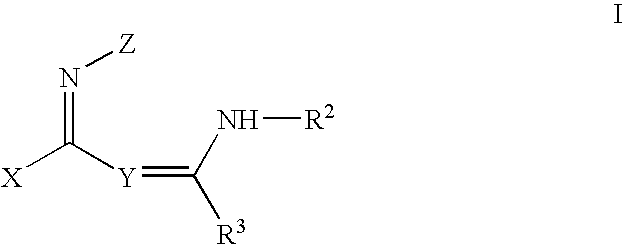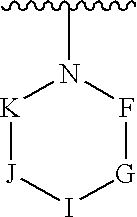Muscarinic receptor agonists
a technology of muscarinic receptor and agonist, which is applied in the field of muscarinic receptor agonists, can solve the problems of inability to unambiguously establish the biological role of individual receptors, induce cognitive impairment in normal subjects, etc., and achieve the effects of improving neuronal processes, increasing cholinergic response, and enhancing cholinergic neurotransmission
- Summary
- Abstract
- Description
- Claims
- Application Information
AI Technical Summary
Benefits of technology
Problems solved by technology
Method used
Image
Examples
example 1
Scheme 1
N-Phenyl-N′-(2phenylimino-pyrrolidin-1-yl-methyl)-benzamidine
Step A
Intermediate of Formula II
(Z=Phenyl, X=Pyrrolidine)
[0227]A solution of pyrrolidine (8.18 g, 0.115 mol) and triethylamine (11.6 g, 0.115 mol) in diethyl ether (20 mL) was added dropwise to a cold (0° C.) solution of phenyl isocyanide dichloride (20.0 g, 0.115 mol) in diethyl ether (200 mL). After addition was complete, the mixture was stirred at 0° C. for 1 hour and then allowed to warm to room temperature (20 minutes). The reaction was filtered and the filtrate was added dropwise to a saturated solution of ammonia / isopropanol (600 mL). After 1.25 hours, excess ammonium chloride was removed by filtration and the filtrate was concentrated. The residue was redissolved in isopropanol (250 mL) and hydrogen chloride (g) was bubbled through for 5 minutes. After concentration, the pale yellow gum was triturated from diethyl ether to yield an off-white solid (24.20 g, 93%), hydrochloride salt.
[0228]1H-NMR (DMSO-d8) δ ...
example 2
Scheme 2
N-(4-Fluoro-phenyl)N′-(phenylimino-pyrrolidin-1-yl-methyl)-benzamidine
Step A
Intermediate of Formula V
(X=pyrrolidine: Z=R3=Phenyl)
[0231]A solution of pyrrolidine (0.55 mL, 6.61 mmol) and triethylamine (0.92 mL, 6.61 mmol) in diethyl ether (10 mL) was added dropwise to a cold (0° C.) solution of phenyl isocyanide dichloride (0.9 mL, 6.61 mmol) in diethyl ether (15 mL). After 40 minutes, the reaction was filtered. The filtrate was re-cooled to 0° C. and a solution of benzene carboximidothioic acid, methyl ester (prepared according to the methods described in Eur. J. Med. Chem., Chim. Ther., 12, 365 (1977), and Australian J. Chem., 30, 2225 (1977)) (1.0 g, 6.61 mmol) in diethyl ether (5 mL) was added. The ice bath was removed and the mixture was heated to reflux for 19 hours. Solids were removed by filtration and the filtrate was concentrated. The residue obtained was washed with diethyl ether to yield (1.77 g, 76%) an off-white solid, hydrochloride salt.
[0232]1H-NMR (DMSO-d8) δ...
example 3
Scheme 3
N-[(2-Methyl piperidin-1-yl)-phenylimino-methyl]-N′-phenyl-benzamidine
Step A
Intermediate of Formula VIII
(Z=R2=R3=phenyl)
[0235]A solution of sodium thiocyanate (18.8 g, 0.32 mol) in acetone (400 mL) was added dropwise to a stirring solution of benzene carboxyimidoyl chloride, N-phenyl (50.0 g, 0.32 mol) in acetone (120 mL) at 0° C. After 1 hour, the reaction mixture was filtered (10-20μ) and the filtrate was re-cooled to 0° C. Aniline (23.7 mL, 0.232 mol) was added dropwise and the reaction was allowed to warm to room temperature. After 1.5 hours, the precipitate formed was collected by filtration to yield a pale yellow solid (49.12 g, 64%).
[0236]1H-NMR (DMSO-d8) δ 10.61-10.88 (m, 1H), 9.80-10.21 (m, 1H), 7.40-7.75 (m, 9H), 7.21-7.38 (m, 4H), 6.97-7.15 (m, 2H)
Step B
Intermediate of Formula VII
(Z=R2=R3=phenyl)
[0237]Methyl iodide (6.8 mL, 0.11 mol) was added to a suspension of the product from Step A (33.0 g, 0.1 mol) in methylene chloride (450 mL) at room temperature and then t...
PUM
| Property | Measurement | Unit |
|---|---|---|
| temperature | aaaaa | aaaaa |
| temperature | aaaaa | aaaaa |
| temperature | aaaaa | aaaaa |
Abstract
Description
Claims
Application Information
 Login to View More
Login to View More - R&D
- Intellectual Property
- Life Sciences
- Materials
- Tech Scout
- Unparalleled Data Quality
- Higher Quality Content
- 60% Fewer Hallucinations
Browse by: Latest US Patents, China's latest patents, Technical Efficacy Thesaurus, Application Domain, Technology Topic, Popular Technical Reports.
© 2025 PatSnap. All rights reserved.Legal|Privacy policy|Modern Slavery Act Transparency Statement|Sitemap|About US| Contact US: help@patsnap.com



